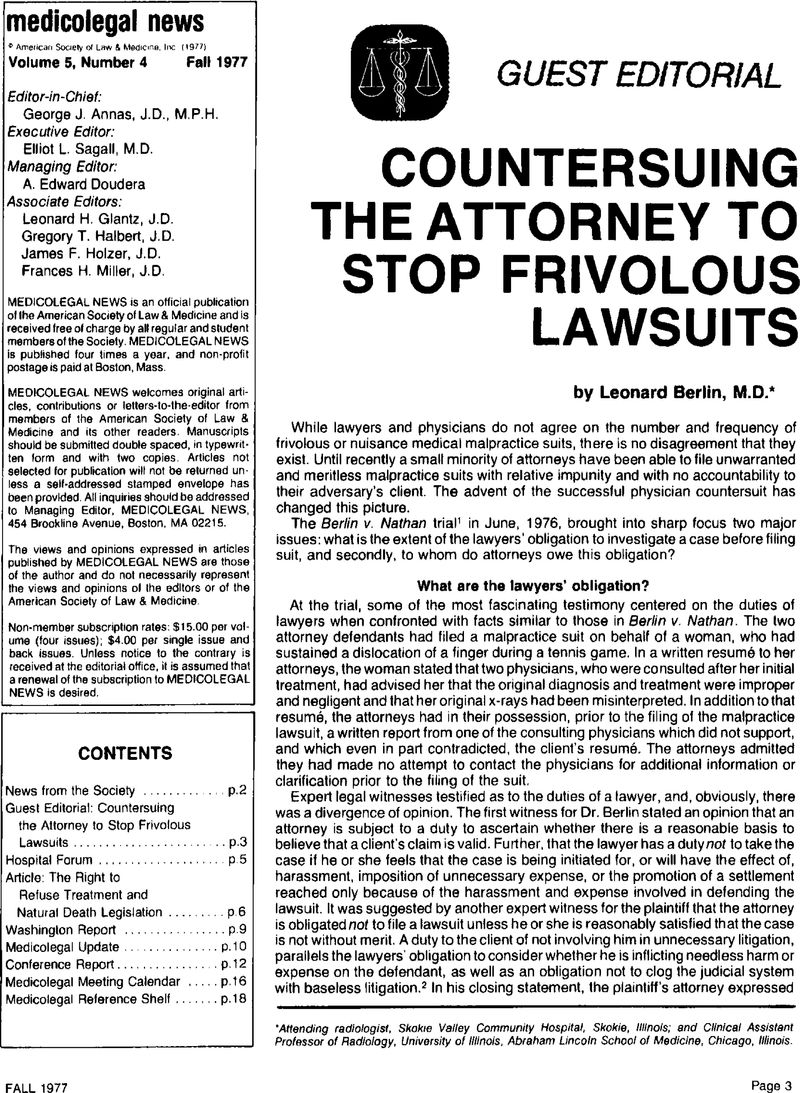No CrossRef data available.
Article contents
Countersuing the Attorney to Stop Frivolous Lawsuits
Published online by Cambridge University Press: 01 January 2021
Abstract
An abstract is not available for this content so a preview has been provided. As you have access to this content, a full PDF is available via the ‘Save PDF’ action button.

- Type
- Guest Editorial
- Information
- Copyright
- Copyright © American Society of Law, Medicine and Ethics 1977
Footnotes
*
Attending radiologist, Skokie Valley Community Hospital, Skokie, Illinois; and Clinical Assistant Professor of Radiology, University of Illinois, Abraham Lincoln School of Medicine, Chicago, Illinois.
References
Berlin v. Nathan, No. 75 M2–542 (consolidated with 75 L 16838) (Cir. Cf., Cook County, III. June 1, 1976). The original malpractice action was withdrawn prior to trial.Google Scholar
This expert witness went further to explain the attorneys' obligation to uphold the truth. Under cross-examination by defense attorney, the following exchange occurred:Google Scholar
Q: Is it correct that an attorney owes an obligation to his client to believe that client?Google Scholar
A: I don't think he has an obligation to believe his client to the exclusion of the objective facts, He has an obligation to tell the client that he has an apparently unwinnable case, and if the client insists on proceeding, that client should proceed without the attorney.Google Scholar
Q: You don't believe a lawyer has an obligation to protect his client's right to her day in court?Google Scholar
A: Only if he believes that client has a colorable case.Google Scholar
At trial, the plaintiff explored the defendant attorneys' responses to questions about situations where other evidence is inconsistent with that provided by their client.Google Scholar
Q: Wouldn't the fact that the doctor's version of what they had said to the client was different from what she had related to you, have made a difference in your mind as to how you would proceed?Google Scholar
A: That would be an issue only a jury would decide.Google Scholar
Q: Are you saying that if you had called the doctors and they said to you, I never fold her any such thing, that that would not have changed your position?Google Scholar
A: That is correct, sir. I must believe my client if I consider her to be credible.Google Scholar
The defense, in its closing argument, affirmed this view; “A lawyer has an obligation to believe his client. If he can't do that, he is guilty of malpractice, and he has no business practicing law.”Google Scholar
Tool Research & Engineering Corp. v. Henigson, 46 Cal. App. 3d 675, 120 Cal. Rptr. 291, 297 (1975).Google Scholar
Heyer v. Flaig, 70 Cal. 2d 223, 74 Cal. Rptr. 225, 449 P. 2d 161 (1969) (public policy requires attorney to exercise his or her position of trust and superior knowledge reasonably, so as not to affect adversely persons whose rights and interests are certain and foreseable).Google Scholar
In an article entitled Lawyer's Malpractice, Trial Magazine 13(6):2, 9(June 1977), Robert, G. Began wrote:Google Scholar
It is necessary for maintenance of a system of individual justice that everyone be held fully accountable for his own actions. This is especially true of professionals. Anyone suffering loss deserves full compensation. An erring lawyer should be subject to the same remedial action which is available against any other malpractitioner and that includes lawsuits. No-fault lawyering is unacceptable.Google Scholar
See W.D.G., Inc. v. Mutual Manufacturing & Supply Co., No. 76AP-366 (Ohio Ct. of Appeals, Franklin County, November 4, 1976) (attorney must remain immune to litigation brought by anyone other than his client, for if opposite were permitted, attorney might feel restrained in his or her representation of the client); Pantone v. Demos, No. 76L-12425 (Illinois Cir. Ct., Cook County, December 3, 1976) (such restraint upon attorney would be “intolerable”); Drago v. Buonagurio, No. 15 (New York Super, Ct., Schenectady County) (contrary to public policy to hold attorney responsible for instituting frivolous action on behalf of client for to do so “would operate to discourage free resort to the courts for the resolution of controversies”).Google Scholar
ABA Code of Professional Responsibility, DR-102-A-1 and EC7–10.Google Scholar
Zelle, L Stanhope, WH, Lawyer Malpractice: The Boomerang Principle, Trial Magazine 13 (6): 16–19, 19 (June 1977).Google Scholar
Kisner, P, Maliclous Prosecution: An Effective Attack on Spurious Medical Malpractice Claims? 26 Case Western Reserve Law Review 663 (Spring 1976).Google Scholar
See Bournewood Hospital, Inc. v. Massachusetts Comm'n Against Discrimination, 358 N.E. 2d 235 (Mass. 1976); Professor Wins $1000 in CIA Lawsuit, The Amherst Student, p. 1 (August 18, 1977).Google Scholar




